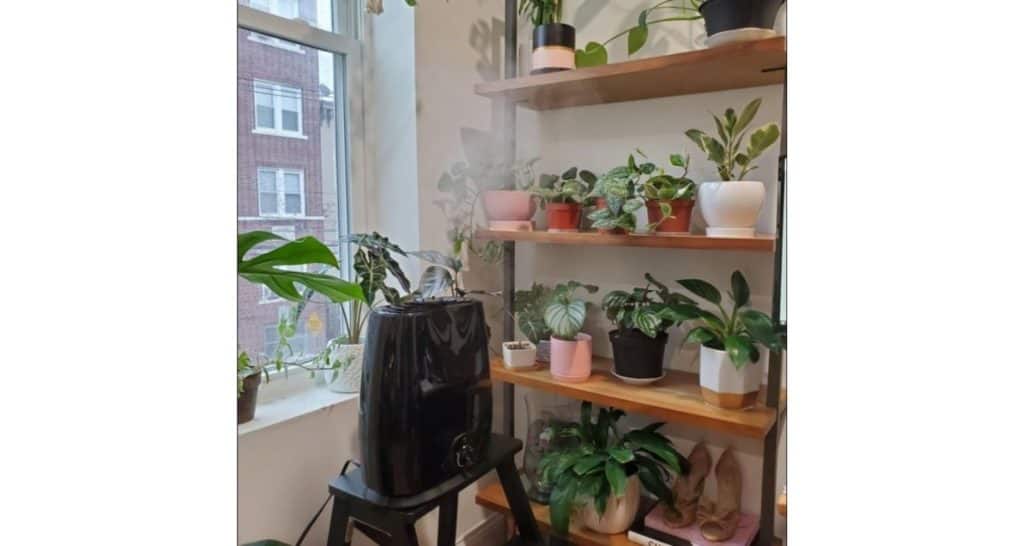Due to its unusual, white, calla-like flowers that stand out elegantly against the shiny, dark green leaves, Peace Lilly or spathiphyllum is one of the most popular decorative plants to make a living or working space more beautiful.
And not only that! The compact herbaceous plant, native to shady parts of tropical jungles, also helps purify the air.
This precious but undemanding plant is not difficult to grow, and with proper care, you can enjoy it for many years. Not to mention peace lilies will reward you with beautiful and fragrant flowers that last up to two months.
However, one of the most common issues with peace lilies are curling leaves. So what makes their leaves curl?
The most common reasons for curling leaves on a peace lily are: too much direct sunlight, too cold/hot room temperature, under/overwatering, and inadequate fertilization. Less common reasons that can cause curling leaves are humidity, overcrowed pot, or pest infestations.
It might look like too many problems for a plant labeled as ” easy to grow“, but do not be discouraged!
Each of these issues can be prevented and treated. So, let’s cover what to do whenever the leaves of a peace lily begin to curl.
1. Peace Lily Leaves Curling From Too Much Direct Sunlight
In its natural habitat, this plant grows under the dense canopy of tall tropical trees, beyond the reach of direct sunlight. Therefore do not expose your peace lily to direct, bright sunlight since it can cause leaf curling, burns, and stains on the leaves.
Solution: Place the plant a few feet away from the south and west window or next to a window facing east or north. There it can enjoy an abundance of bright indirect light.
Do not forget peace lilies are a shade-loving plant and can handle excess shade over excess sun.
2. Peace Lily Leaves Curling Caused By Hot or Cold Room Temperature
Like many other plants from the Araceae family native to the tropics, peace lilies prefer a uniform air temperature without large fluctuations.
Leaf curling is often the result of temperature stress especially when there are sudden temperature changes.
Solution: Keep your peace lily plant in the room where the temperature never drops under 65 °F and goes more than to 80°F. Peace lilies can withstand slightly lower temperatures in winter but not below 45 °F.
However, peace lilies cannot withstand cold temperatures for a long time. So make sure to keep the plant away from doors or windows that open frequently during colder months.
3. Peace Lily Leaves Curling Caused By Underwatering or Overwatering
A consistent and sufficient watering schedule is a crucial element for any plant’s health.
A thirsty or overwatered plant will display signs of stress. Typically the earliest sign of stress is when the leaves begin to curl and dry out.
When To Water Peace Lilies
Generally speaking, peace lilies need to be watered once in seven days, but this is a general rule of thumb. Watering frequency may increase or decrease depending on the size of the plant, the temperature, and season.
Follow these steps in order to determine when to water a peace lily plant:
- Insert your index finger into the soil 1 to 2 inches deep
- Feel for moisture
- Water if the soil is dry
- Do not water if the soil is wet or moist
This watering schedule and moisture detection method also works for most other tropical plants.
The best part of this watering method is that the soil will dry out faster in hotter months which will lead you to water the plant more often. Whereas the plant may not need as many waterings during the winter months since the soil will remain moist longer.
Remember tropical plants are naturally found in humid environments where there’s lots of rainfall. So try to recreate this environment as much as possible in your home.
4. Peace Lily Leaves Curling Caused by Fertilizer
Too much or too little fertilizer can also cause leaves to curl.
Do not be too enthusiastic when it comes to feeding a peace lily. Use the fertilizer for tropical plants every two months during their growing season which is usually from spring to fall.
If you over or under fertilize the plant then there are some steps you can take.
Solution: If curling leaves are the result of under fertilizing then you simply need to provide more fertilizer. Just apply the liquid or dry fertilizer with the water and follow the recommended dosage on the fertilizer label.
If you over fertilize a peace lily then the problem is bit harder to solve. The best solution is to repot the plant since the plant needs to be placed in soil that is not too nutrient rich.
First remove the plant from the soil, wash the roots, allow it to dry slightly before transplanting the plant into a fresh pot of soil. Do not fertilize for at least two months to allow the plant to stabilize.
5. Peace Lily Leaves Curling Caused By Pests
Dust, poor air circulation, and dehydration make an ideal breeding ground for pests. Common pests that infest peace lilies plants are:
- Mealybugs: These pests attach their egg sacs to the leaves and stems. Once hatched and grown into adult bugs, they spread to other leaves, stems, and in the soil.
- Whitefly: This white-colored insect is found on the base of the leaf. It sucks nutrients from the leaves and excretes a sugary substance that becomes moldy. As the mold grows, it covers the leaves and blocks light absorption.
- Aphids: The palm aphid sucks the sap from the leaves and stem of the peace lily. Like the whitefly, aphids excrete a sugary substance on the leaves that becomes moldy and blocks sunlight.
- Red spider mites: These insects form webbings and make the leaves look dusty and discolored. A light infestation can be treated. However, heavy infestation may mean getting rid of the plant to prevent any spread to other plants.
Common treatment for most indoor pests is to create a warm soapy water spray that can be applied directly onto the bugs and plants. This homemade insecticidal spray is safe to use on plants and safe to spray around kids and plants.
View this guide on how to make your own homemade insecticidal soapy spray.
Just make sure to use castile soap instead of any scented soaps or dish soaps. Most scented or dish soaps are actually a detergent which will damage the plant’s leaves.
6. Peace Lily Leaves Curling Caused By Low Humidity
Peace lilies prefer a higher humidity environment similar to their native tropical homes. The ideal amount of humidity is 60% or more, but a peace lily can withstand slightly lower humidity levels.
A typical side effect of low humidity levels are curling leaves. The leaves of a peace lily will curl in order to try to retain moisture from the dry air.
Thankfully there are a few solutions for creating a more humid environment.
Placing Peace Lily In High Humidity Rooms
The first option is to put your peace lily in a brightly-lit bathroom or indoor pool area. Both of these rooms or areas are high in humidity which is exactly what peace lilies prefer.
If your bathroom does not have natural light then you can either use indoor grow lights or follow one of the other options below.
Creating Humidity For Peace Lily
Using a pebble-tray can provide humidity while also helping to protect the peace lily from overwatering.
Pebble trays are a low cost way to provide humidity to tropical plants.
Alternatively, you can place a humidifier in the room with all of your tropical plants. A humidifier will allow you to adjust the settings to provide the right amount of humidity year round.

I use this humidifier in my room and it lasts for about 2 days before needing to be refilled. I highly recommend it for a low maintenance way of keeping the room humid.
Misting Peace Lily Plants
The third option for providing more humidity to peace lilies is to periodically mist them.
The peace lily can be misted with room temperature water every day in the spring/summer months to provide moisture, and every 1-2 days in the fall/winter months.
The ideal humidity range for the peace lilies is anywhere between 40 and 80 percent. Ideally peace lilies prefer the humidity to be around 60 percent.
You can buy a tool called a hygrometer, which can help you keep track of your humidity levels.
7. Peace Lily Leaves Curling Caused By Overcrowded Pot
Although the peace lily likes its roots to be a little “squeezed” in a smaller pot, the plant still does not want to be cramped into a tiny pot.
If the plant is too big and the flower pot too small, the leaves will not get enough food or water, which can eventually cause them to twist and look unhealthy.
Solution: Repot the plant into a larger container. Use peat-based soil along with perlite to ensure good permeability. Remember that peace lilies should not be grown in a pot wider than 10 inches. So if the plant is too big, then it is better to split the plant. A new plant can adorn the new corner in your home or a nice gift for a friend.
Final Thoughts
Peace lilies are a beautiful plant that can be successfully cultivated even by beginners.
All this modest tropical beauty requires is a moderate temperature, sufficient watering, and bright indirect lighting. Peace lilies can tolerate shady positions much easier than many other house plants.
As long as you can provide it with minimum growing conditions, this plant will bring a breath of tropical atmosphere into your home or workspace.

